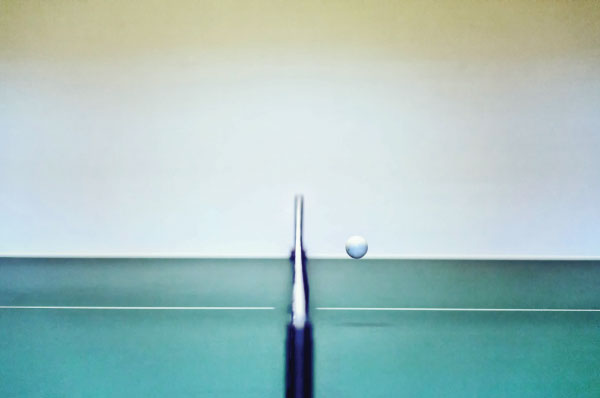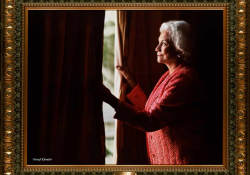Ping -Pong; or, Writing Together

The great games will be remembered for a lifetime, just as we cannot give up on our failures, either. The muscles record the beautiful strokes; the possible, yet unrealized, potentialities ache in the place shared with the soul.
The official name of ping-pong is table tennis. Writing together has neither an official nor a nickname. For want of a better term, they call it writing for four hands, writing for two hands (after all, only one plus one hand is engaged in it), or simultaneous writing. When Gáspár Kornis worded his “brief politia” about the state of his family and of Transylvania at the end of the seventeenth century, he named God as his co-author and termed their writing together kairos: “I commit my lines to paper in the kairos sanctified by the manifold visitations of the Lord of Heaven.” One of the best handbooks on ping-pong, translated into all major languages, even into Chinese, was written by Farkas Paneth from Kolozsvár. There are next to no treatises on writing together, however, and if it gets mentioned at all, it is brought up as an example of “impossible possibility” or dismissed with a joke. Hannah Arendt wrote to Heidegger in a letter enclosed in a copy of The Human Condition, fresh off the press: “If true things had ever passed between us—I mean between us, not with You or me—I would have asked if I could dedicate this book to you.”
Here we must mention in passing that mere correspondence does not qualify as writing together. The letters of Kafka and Milena were born from solitary writing apart. Perhaps the reason why writing together is so rare is that it is rarely assumed in public. Rumor has it that Dominique Aury wrote Story of O together with her illicit lover Jean Paulhan, but they both vehemently denied it. Tristan Tzara and his circle often wrote together, but they did little more than reassemble their separate sentences in an arbitrary order. To the question how The Twelve Chairs was written, Ilf and Petrov would answer jokingly that one of them was responsible for the vowels, the other for the consonants.
Ping-pong is realizing that you have a third eye.
One of the biggest problems of writing together is the lack of a writing-together table. The ping-pong table, on the contrary, is given: nine feet in length, five in width, and thirty inches high (in centimeters the numbers are messier). The net is six inches tall and six inches wider than the table on both sides. The ball, one and a half inches in diameter, shall, when dropped from a height of twelve inches, bounce up to ten inches from the table. Similarly, internationally established rules codify everything, from freehand serving to variable racket size. Obviously, something more is needed in order for the game to start. But even once it starts, we cannot be sure that it is going to be true ping-pong. What is ping-pong?
They say Plato would not understand ping-pong, for ping-pong is “not wholly given for the eye.” The one who doesn’t play can hardly imagine how much ping-pong is the ear’s sport. All players have experienced the state (even if it only lasted for a few glowing moments) when suddenly there are no errors in the rally and every single stroke sends the ball to its desired destination. The brain suddenly gains insight into the future and knows beforehand where the ball is to land. And this premonition is triggered by the ear. The ping on the adversary’s racket signals the ball’s expected arc, speed, the strength of topspin or backspin. And when the ball touches on the table, the table’s sound is a further signal. The eye cannot possibly see if the ball is spinning, let alone at what speed, but the sound left on the table provides the answer to this question, too. “The sound left on the table,” I say, although this sound overtakes the ball in the batting of an eyelash (not even the fastest strokes are faster than sound’s speed), and it reaches my ear long before the ball could reach my bat: I have time to ponder what kind of backswing I should employ.
Ping-pong is realizing that you have a third eye.
In 1936 at the Prague world championship, Farkas Paneth played a rally of two hours and seventeen minutes to score one point. With Tamás Reiter they were invincible for a long time in doubles. The former was tall and lean, poised, almost standoffish; the latter short, quick of movements, and energetic. “We have played for entire nights for our own entertainment. In the vicinity of Tomi I simply never felt tired.” Another legend, Angelica Rozeanu, who is considered the best female player of all time (she obtained no less than seventeen world champion titles; in the individual game she became world champion six times in succession), played endless rallies with a law student from Szatmár in a deserted Bucharest sports court. On one occasion they played for eighteen hours without stopping, without food or drink.
In front of an audience, ping-pong is emptied out.
It is not easy to find a true partner for the game. Everybody is looking for the unconditional, while running into an endless series of conditions. Can you spare time for me? Would you fancy playing with me? Do you have enough courage to show your weaknesses? To show the well-kept secret of your serving? (The odds of finding your ideal partner are, according to Drake’s allegedly reliable equation, one in two hundred and fifty thousand.)
For the proficient player, even a beginner can be an ideal partner. Provided, of course, that this beginner is gifted enough and in a short while learns to do a backhand spin. To graze the ball with a single, flashing wrist move. To return it with a counterdrive. To hit it with closed eyes. The most important thing is the sense of rhythm—that your partner feels when to speed up or slow down, is able to unreel the game backward, palindromically, and to restart it. If the harmony of rhythms is adequate, the intensifying resonance will break the game’s habitual nature, will break its boundaries. The inner structure shakes off the outer one, which is revealed to be no more than an overlay: the true, dazzling spectacle is the inner edifice. Many put it down to fast reflexes, but reflex comes a miserable second to the sense of rhythm. (Farkas Paneth was thrice put on a train bound to Auschwitz, and three times he managed to escape—“thanks to my sense of rhythm.” He walked off from between two gendarmes under cover of the white steam let off by the stationing train. Spielberg shot a two-hour documentary about him, worth watching.)
The theoretical works on musical pieces for four hands also rank the sense of rhythm first on the list of indispensable skills for playing together. It is no accident that the capacity for concentration comes second. Further abilities are the sense of form, interpretation, dynamics, observation, aural memory, a sense of tonality, the reading of the melody line, skills of playing the instrument (surprisingly, tenth in order of importance), reading the score, a sense of style. The one to compose the most for four hands was Robert Schumann, and it is his exhortation that is echoed by teachers encouraging their students to engage in four-handed play: “Do not miss any opportunity to play music with others. Only so will your playing become fluent and vigorous.”
When I return the ball, pong, my backswing is not only an answer but a question, too. One I put happily. We write letters more happily if we know that the addressee is preparing excitedly for the answer. If I know that my partner keeps thinking of the game even when not playing. The conjured-up future fills her present, just as it fills my present. We carry each other in our comings and goings as we carry our shoulder bags containing the most indispensable things. My partner returns the ball with a new movement, not diagonally but straightly, in a line parallel with the table’s longitudinal axis. “Straight forehand” is what I call it. What will my answer be like? It goes without saying that I will use a backhand slice to return the ball, but not diagonally as I would normally do: I will send it straight, just like my partner; barely noticeably I will change the tilting angle of the racket and will spin the ball along an evolvent curve. With this stroke I signal to my partner that I have interpreted her stroke, taken over the new word she created, and while broadening its meaning (backhand instead of forehand), I have also preserved the question in my answer. I might say, not only have I answered but onswirled. I have validated the question with the answer. We go back to the moment of the emergence of language, we taste the state, pure like springwater, of language’s appearance. Ping-pong is by far not about hitting a ball to and fro.
We go back to the moment of the emergence of language, we taste the state, pure like springwater, of language’s appearance. Ping-pong is by far not about hitting a ball to and fro.
In his oft-quoted 1937 German letter, Samuel Beckett explains his intention to abandon English by the motive that his mother tongue presses itself on him like an ever-more stifling veil that he has to tear apart in order to arrive at the things lying beyond it. True ping-pong offers a chance to arrive at these things without forcing us to abandon our language—because our language and ping-pong overlap. Through ping-pong I can touch my partner. I can feel my partner’s heartbeat, the warmth of her blood pumped into the muscles, even the way the tiny glands squeeze the sweat-drops out of themselves. I can feel the hardness of the table, the vibrations provoked by the ball’s lively wall, the delayed tension released from the minute craters hollowed in the bat’s rubber. (I can tell from experience that the ear trained on ping-pong can “hear” if the water running from the tap is still cold or already warming up.)
If we put the question now, What is ping-pong?, the answer will be unequivocal because the answer is voiced in the language of ping-pong. Qu’est-ce que c’est? Ce este? Micsoda? What is it? In whichever language I should put it, the language tries to influence the answer to come with its method of interrogation. But if the question is put in the language of ping-pong, any answer to it will also be in the language of ping-pong, and I am thoroughly comprehended in this answer. The language of ping-pong transports me to my nakedness, to the flawless core of my being, to veil-lessness. There is no external will, desire, intention to encroach on me or on my answer. It is no question if I understand the question or if my partner understands the answer, for we are both inside it. We are shaped like the ball’s sphere between ping and pong.
I suck the other to bare bones without even touching.
I know of the game without an audience between Angelica and the young law student from the shady allusions of an aged lawyer from Szatmárnémeti. We all put on roles in front of the dedans.* Playing to the public covers up the real game because everything is shaped according to expectations. In front of an audience it is shameful to return a ball that had ricocheted to the floor, it is forbidden to use one’s foot, and it is improper to emit cries and groans of delight. Playing in front of an audience is not true ping-pong but merely the justification of ping-pong. Obviously, justification of what is true is important, but for this purpose game rules would do just as well. True ping-pong encounters the public through its rules.
What is the most frequent impediment to true ping-pong?
We might say in general: the greatest impediment is that we are possessed by the will to win. To be more concrete, let’s take a few typical cases:
I want to be the one who hits back my own serve. I rush to my partner’s place in a flash and, simply pushing her aside, return my ball to myself. Throughout the game I never for a moment cease to enthuse about how fantastically we are suited to playing together.
I am dying to play with a blond Swede. I simply adore the odor of Swedes (especially if they are blond). But there is no Swede around; I have to do with the dark-haired creature at hand who has dandruff on top of all. I serve high loops hoping she can return them and I will have the occasion to exclaim in wonderment what a gifted partner I am blessed with.
I have chronically low self-esteem. The moment the other returns my serve with a fault I withdraw, smarting. Is my partner mocking me? Or imitating me? Mimicking my ugly penhold grip in jest? Here I go, all cramps, oh my how it hurts!
Lack of curiosity. A soft-core, almost philosophical egotism, the bright shine of the sun, a certain form of genius. It does not require companions. Wells up with never-heard-of words and delights in them, not eager to know the other’s interpretation, mind, brain, brain fluid, anything.
Fatigue. Could we have lunch at two instead of ping-pong? I don’t feel attracted to the other’s forehand at all. Neither can I understand her topspin, although the upward-lifting force of Bernoulli’s principle has always excited me. Not now, though. The short serves dropped directly behind the net are equally inexpressive. Let’s have a nap rather. There is no playing together.
Ping-pong is not the onset but the manifestation of something. For this very reason it is impossible to play ping-pong on one’s own. To serve to and receive from a vertical half-court (such tables are sold in chain stores) has nothing to do with ping-pong. Bobby Fischer has compared playing chess with oneself to masturbation, admitting that it has positive sides and drawbacks. In the case of masturbation, the imaginary works wonders—see Thomas Mann’s famous onanism at eighty, in the kairos of the imagined Zurich waiter boy, or the morale of the masturbations of poet István Vas: the delight of delights is the imaginary’s emphatic wonderment at itself. But one cannot imagine a partner for oneself in ping-pong. (Perhaps Glenn Gould alone could have played rallies with the vertical table, for each note he struck on the piano was a dialogue with the instrument.)
The most radical impediment occurs when ping-pong is banned by a state. This happened in the Soviet Union under Stalin: between 1930 and the early 1950s the game was prohibited on account of its alleged harmful effects on health (!). There is no ping-pong in Russian, only table tennis. (Moreover, “Ping-Pong” was an invention of capitalist industry to sell the selfsame equipment, trademarked as different from table tennis.) When I was looking for a ping-pong ball in the Marosvásárhely sporting-goods store selling made-in-China equipment, the Chinese shop assistants chortled as though I had tried to order some 69-like sex services. In Hindi, ping-pong (“lakdrhi ke takte pé dé dhadrha drh lé dhadrha drh”) stands for “I hit it back to you if you hit it back to me,” and according to Indian writer and one-time ping-pong player Giti Thadani, the name comes from Sanskrit, which proves that the game is much, much older than we would suppose.
We can only imagine the dream ping-pong of Farkas Paneth and Angelica Rozeanu; there is no evidence of it whatsoever. Paneth was buried last year in Kolozsvár; Angelica Rozeanu, three years earlier in Haifa. The great games will be remembered for a lifetime, just as we cannot give up on our failures, either. The muscles record the beautiful strokes; the possible, yet unrealized, potentialities ache in the place shared with the soul.
The reason I got entangled in all this is a scene from 1972. Two people are playing in the basement gym of a school in Szatmárnémeti (the one with the most patina in town, although patinas had already become somewhat outdated in those days): one of them is the school’s teacher of Hungarian, the other is perhaps his disciple, perhaps his colleague, perhaps his love; there is no telling, although she can hardly be his love with that dramatically ugly, pimpled face, sticking-out ears, and red hair. I am watching them stealthily, my favorite teacher and the ugly girl (back then freckles, sticking-out ears, and red hair spelled ugliness, but they no longer do), squatting among the dahlias in front of the basement window. My teacher returns a lob that bounces very high by jumping in the air like a ballet dancer; his soles are level with the ping-pong table. The ugly girl manages to return his strong forehand drive; my teacher again flicks back and downward her high loop. This the girl manages to graze, sending the ball in a line close to the table, into the left-hand corner. She has surprised the man whose movement is arrested; he barely manages to flick the ball back. And now the girl’s forehand speed drives and the man’s defensive, grazed loops take turns repeating each other several times. But not for long. All of a sudden they change style, starting to return the strokes ever closer to the table: the balls flick like bullets from a machine gun; it is utterly unbelievable that they do not miss a single stroke. They barely look at the ball, merely raising their rackets to block its path; only their elbows are flashing. My teacher slightly alters his movements before striking; he slackens his right knee ever so slightly, then stretches it, so his drives get more speed. This is taken over by the girl, who adds a slight tilting of the elbow that sends her balls lower and lower, almost grazing the net. What had started as pong-pong turns into ping-pong, then into ping-ping. The man, too, raises his elbow, tilting at the same time his bat downward, giving a bit of spin to the ball: peng-ping. In response the girl holds out her bat vertically, which the man, as if afraid that this might slow down the pace of their exchanges, resets into a more acute angle with a movement that looks like spooning up honey, speeding up the ball’s spin, as if they were playing variations orchestrated to two ping-pong bats and a table. Perhaps it is their third eyes mentioned at the beginning, opening to each other. Ping-peng, pong-pyong, pang-ping, the various strokes are interlocking in a fugue, then everything takes a new direction, inversione della fuga: ping-pang, pyong-pong, peng-ping. At this moment the gray-haired teacher takes a step back and lets the ball fall toward the floor. What happens now: he doesn’t move. But before the ball hits the floor he reaches out to it, leaning forward with his whole body, and with a light move of his wrist he raises it. The ball flies in an acute angle upward, first toward the ceiling, then downward, dropping to the table. After the fast flickers of the past few moments time seems to stand still. Nothing stirs. Even the bugs’ humming stops among the dahlias. And finally the ball hits the table in front of the girl, bouncing up very high. And it is the girl now who jumps up; she springs in the air with flushed, glowing face, raising her bat like a halo above her glorious copper head as she soars, beautified, hovering like an angel toward the ball.
Translation from the Hungarian
By Erika Mihálycsa














